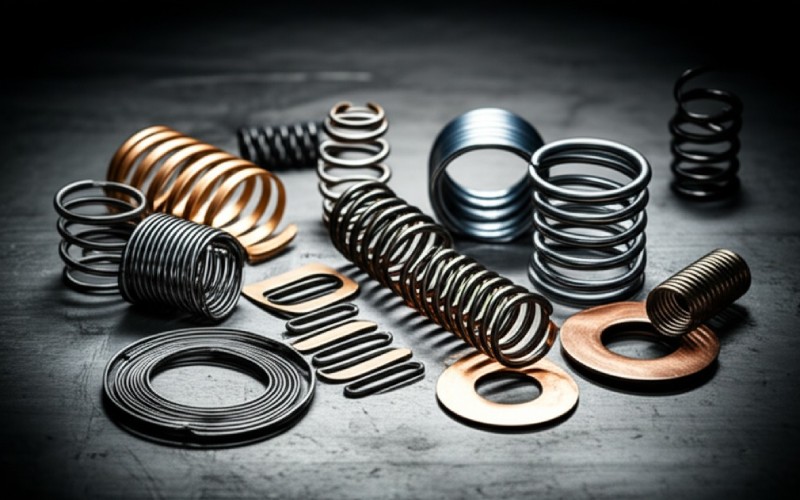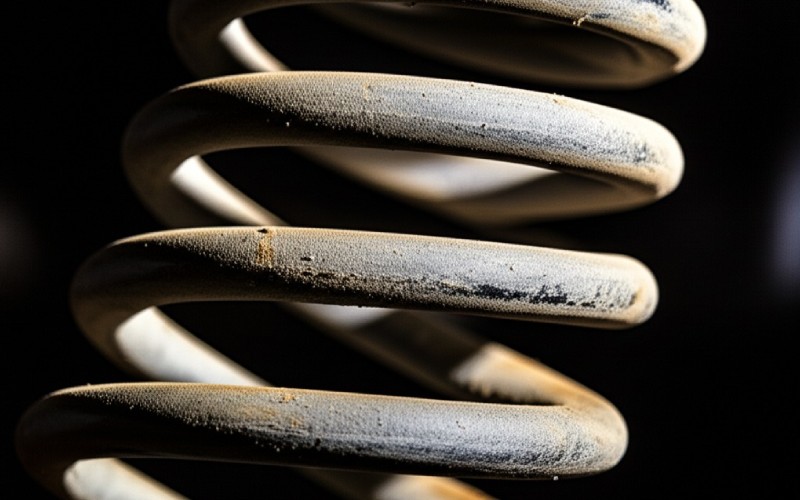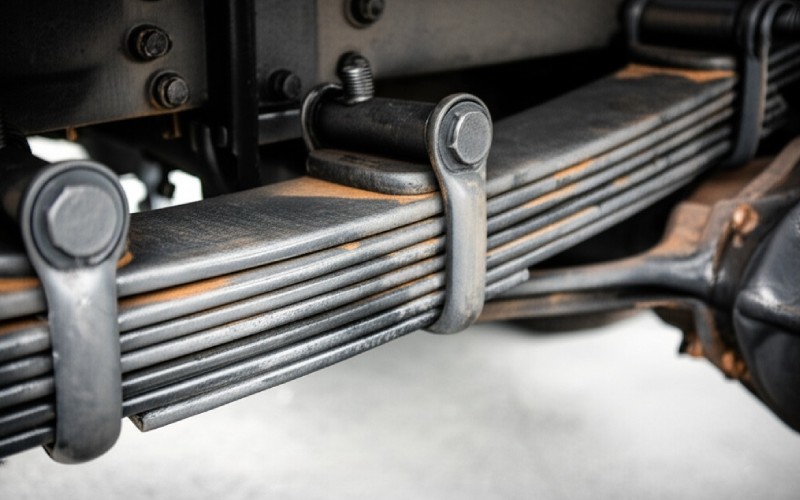Lad Istar hjælpe dig med at komme i gang med dit projekt med vores erfaring og knowhow!
Upload dine designfiler og produktionskrav, så vender vi tilbage til dig inden for 30 minutter!

In this article, I’ll walk you through the many different types of spring. We will look at springs and their applications. By the end, you will understand how they work and which type of spring is right for your needs.
Most springs fall into a few big groups. When we talk about mechanical springs, we are talking about simple devices that store energy. When you bend, stretch, or squeeze them, they store mechanical energy. When you let go, they release that energy. This simple action makes them useful in applications of all kinds.
Den main types of springs are usually grouped by their shape. The Hovedtyper are helical springs, which are shaped like a coil. Then there are leaf springs, which are made of flat bars. Finally, there are disc springs, which look like a small, cupped washer. Understanding these common types of springs is the first step to understanding the use of springs in the world around us. There are many types of springs, but these three groups cover most of what you’ll see. This is a good type of spring to start with.
Let’s look at the most common spring family: the helical spring. A helical spring is a type of coil spring. Within this family, there are two Hovedtyper. The first are compression springs. You can think of them as “pusher” springs. When you squeeze them, they push back. The spring in your car’s suspension is a big compression spring. A smaller one is in your ballpoint pen. These springs are the most common type of spring.
The other kind are extension springs. These are “puller” springs. They are made with their coils tight together. When you pull on them, they stretch out. They want to snap back to their original size. For example, when fixing the screen door on your porch, the extension spring is the part that pulls the door shut. This is also how the springs in many garage doors work. Understanding both compression springs og extension springs er nøglen.
Now, let’s talk about twisting. A torsion spring er en særlig type of spring that works differently from the ones we just discussed. Instead of pushing or pulling along a straight line, a torsion spring works with a twisting force, or torque. The ends of the spring rotate around a center point. It is a very clever type of spring.
Think of a simple clothespin. The little torsion spring in the middle is what provides the clamping force. A mousetrap is another great example where a powerful torsion spring is used. When you set the trap, you are winding the spring, and it holds that energy until it is released. Torsion springs used in this way show how a rotational force can be very useful. The torsion spring is an essential component in many simple machines. A torsion spring is a great choice for this kind of work.

Have you ever looked under an old truck or a heavy-duty trailer? If so, you have probably seen leaf springs. They don’t look like a typical coil spring. Instead, leaf springs are made of long, flat plates of steel stacked on top of each other. These springs are typically made this way to be very strong and durable. Leaf springs are made to handle very heavy loads.
The main job for leaf springs is in vehicle suspension. They do a great job of supporting the weight of a vehicle while also absorbing bumps from the road. There are different types of leaf springs. The most common is the semi-elliptical spring. You might also see a quarter elliptical leaf spring eller en transverse leaf spring, which runs across the car’s frame. For leaf springs and their applications, think heavy-duty. The design of semi-elliptical leaf springs is simple and effective. A quarter elliptical spring is another common design.

A disc spring is a very interesting type of spring. You may also hear it called a Belleville washer or a belleville spring. They don’t look like a spring at all. They look like a small, cone-shaped washer. This unique shape is what gives them their power. When you press on a disc spring, it flattens out.
The real magic of disk springs is that you can stack them in different ways. Stacking them in the same direction makes a very stiff spring. Stacking them in opposite directions gives you more travel. This makes disk springs incredibly versatile. They are ideal for applications requiring a very high force in a very small space. You will find disk springs in things like clutches, brakes, and valves. There are many types of disk springs, herunder wave disk springs og en slotted disk springs, each with special uses. This disc spring is a powerhouse.
The world of springs is big! There are many different types beyond the ones we have covered. The spring types and their applications can be very specific. Knowing about these less common ones can be really helpful for your projects. There are many types of springs to choose from.
One type is flat springs. These are often simple pieces of stamped metal that are bent into a shape that allows them to act as a spring. Another interesting type is constant force springs. Disse springs that provide the same amount of force no matter how much you unroll them. A steel tape measure uses a constant force spring to retract the tape. We also have spiral springs. You might find these inside old mechanical watches or clock springs. Disse flat springs are easy to make.
You can’t just make springs out of any metal. The spring material is one of the most important parts of spring design. Den material used must be strong but also very flexible. It needs to be able to bend or stretch thousands of times and still have the spring returns to its original shape. Springs are made from very specific alloys.
Den types of materials used in making springs often include high-carbon steels, alloy steels, and stainless steel. The used in making process often involves heat treating to give the material its “springy” quality. For some jobs, springs are made from materials like bronze or titanium, especially if they need to resist rust or work in high temperatures. The material used is key. Choosing a material that is suitable for making springs is the first step.
God spring design is both an art and a science. It’s not just about the material. The shape, size, wire thickness, and number of coils all have a big effect on how the spring behaves. The goal is to design springs to meet the exact needs of a specific job. Springs used in product manufacturing must be perfect.
A key idea in spring design er den spring rate. This is just a way of saying how stiff the spring is. A stiff spring has a high spring rate, meaning it takes a lot of force to compress or extend a spring. Designers can also create variable rate springs. These springs get stiffer the more you compress them. This is often done with conical springs, which are shaped like a cone. For very precise jobs, engineers might use machined springs, which are cut from a solid block of material. A linear springs design provides a constant spring rate.
Let’s dive into some more springs and their applications. Modern cars, for example, often use air springs som suspension springs for an extra smooth ride. An air spring is basically a strong rubber bag filled with pressurized air. The air acts as the spring. These are used in applications where comfort is key.
We talked about leaf springs, but there are creative ways to use them. A transverse leaf spring can be created by connecting two semi-elliptical springs in opposite directions. This forms a full-elliptical spring. Sometimes a quarter elliptical spring is all that is needed. And with disk springs, you have special types like slotted disk springs that change how the spring behaves. The applications of springs are almost endless because springs are integral parts of so many devices.
At vælge den rigtige spring type really comes down to what you need the spring to do. Springs and their uses are directly connected. The different types of springs used will depend on the job.
Do you need to push two things apart? You probably need compression springs. Do you need to pull two things together? Then extension springs are your answer. Is a twisting or rotational force needed? A torsion spring is the right tool. Do you need to support a very heavy weight in a vehicle? Leaf springs are a good bet. Do you need a huge amount of force in a tiny space? Then disk springs are the best type of spring. Thinking about the force you need and the space you have will guide you to the right spring type hver gang. Springs are mechanical components that solve problems. Springs are widely used because they are so helpful.
suspension.type of spring is just the start. The material it’s made from and its specific design, like its spring rate, determine how it will perform.